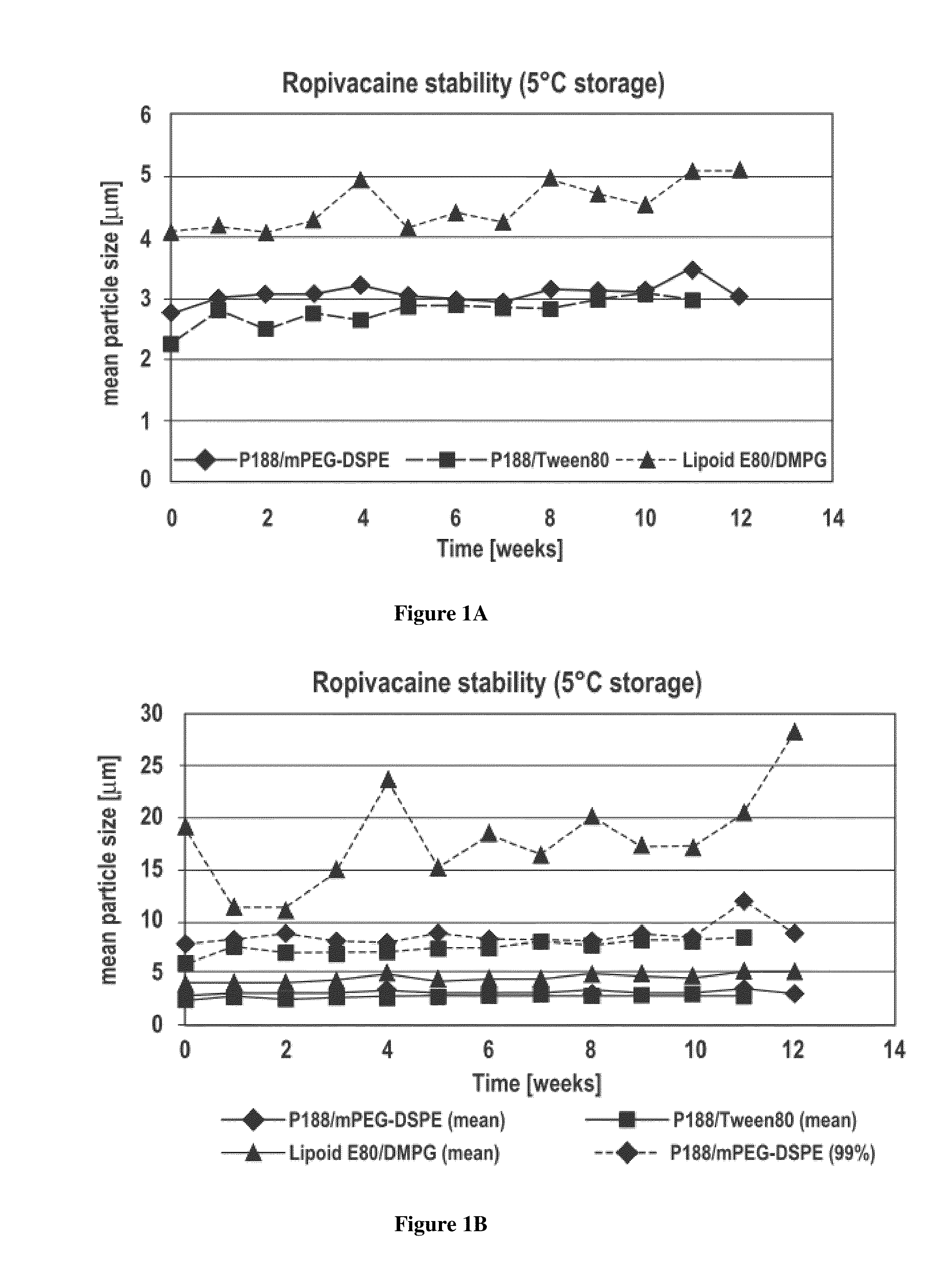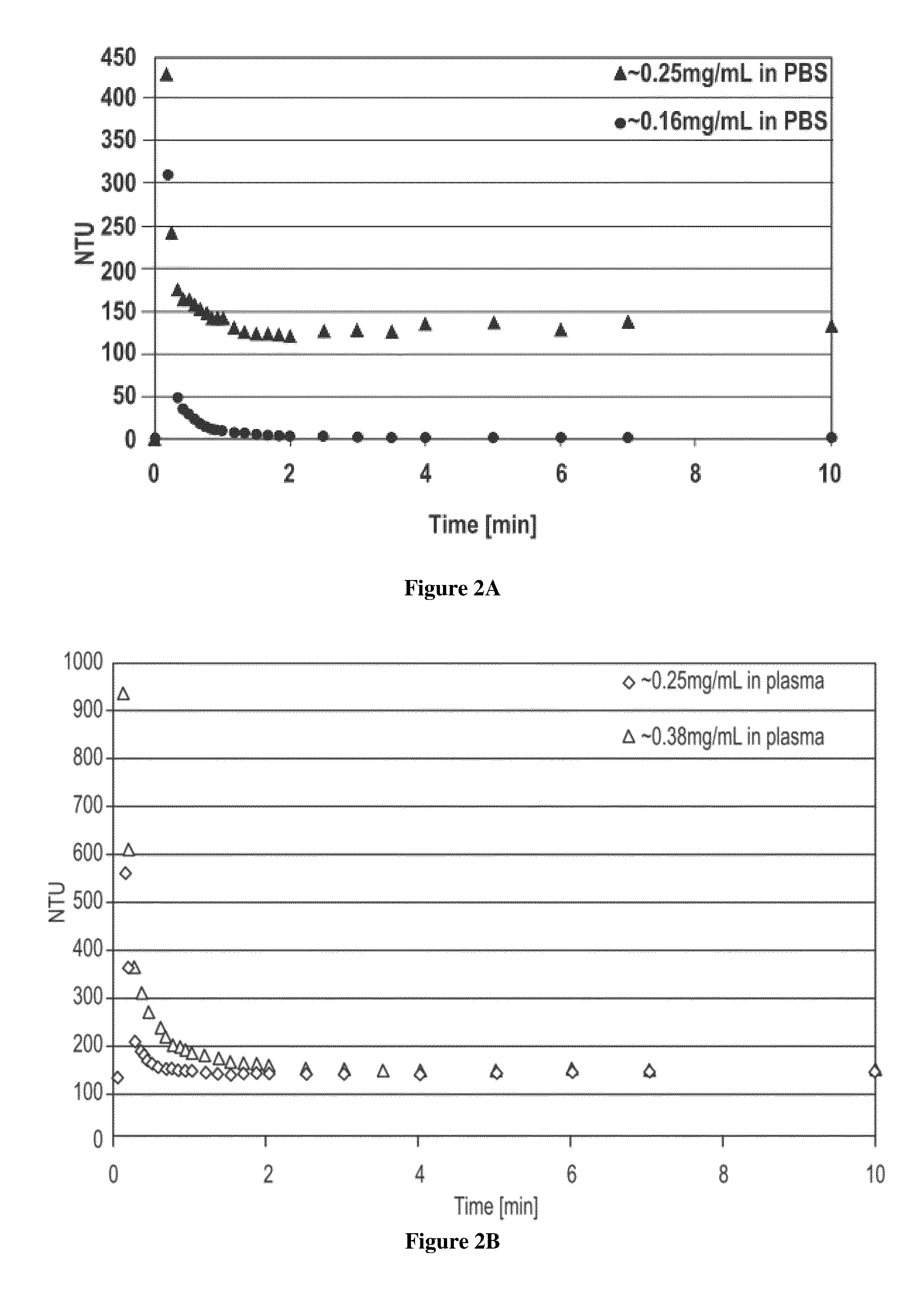Methods And Compositions For Reducing Pain, Inflammation, And/Or Immunological Reactions Associated With Parenterally Administering A Primary Therapeutic Agent
- Summary
- Abstract
- Description
- Claims
- Application Information
AI Technical Summary
Benefits of technology
Problems solved by technology
Method used
Image
Examples
example 1
Microparticle Dispersions of an Analgesic Agent
[0088]Dispersions comprising microparticles of the analgesic agent ropivacaine were prepared using an energy addition / homogenization procedure. Five ropivacaine formulations were prepared using ropivacaine hydrochloride as starting material and are described in Table 1 below.
TABLE 1FormulationComponent#1#2#3#4#5Ropivacaine hydrochloride1%(w / v)1%(w / v)1%(w / v)1%(w / v)1%(w / v)Sodium phosphate0.3118g / L0.3118g / L0.3118g / L0.3118g / L0.3118g / Lmonobasic, monohydrateSodium phosphate dibasic,1.0994g / L1.0994g / L1.0994g / L1.0994g / L1.0994g / LanhydrousGlycerin2.25%(w / v)2.25%(w / v)2.25%(w / v)2.25%(w / v)2.25%(w / v)Poloxamer 1880.5%(w / v)—0.5%(w / v)—0.1%(w / v)DSPE-mPEG 20000.2%(w / v)————Polysorbate 80 (Tween 80)——0.25%(w / v)——Lipoid E80—1.2%—1.2%(w / v)—Sodium————0.1%(w / v)Deoxycholate1,2-Dimyristoyl-sn-glycero-———0.2%(w / v)—3-phosphoglycerol, sodiumWaterQSQSQSQSQSParticle Size2μm6μm2μm3μm1.5μm
[0089]To prepare the ropivacaine free base, 4 grams of ropivacaine HCl was added t...
example 2
Microparticle Dispersion of an Analgesic Agent is a Sustained Release Formulation
[0095]The release of ropivacaine from a sustained release fibrin matrix formulation (Tisseel®) was evaluated. Whole, human, citrated blood was centrifuged at 700 rcf for 15 minutes. The pellet was discarded, and the supernatant (plasma) was used for the release assay. Three aliquots of 250 μL of 10 mg / mL ropivacaine free base microparticles (2.5 mg) were prepared for Formulation #1 described above. The aliquots were centrifuged at 8,000 rpm for 5 minutes at 5° C. in 1.5 mL polypropylene microcentrifuge tubes. The supernatants were removed and discarded. The 2.5 mg of ropivacaine free base microparticles was combined with 25 μL of 100 mg / mL fibrinogen and 20 μL of thrombin dilution buffer. Next, 5 μL of 20 IU / mL of thrombin was rapidly mixed into the ropivacaine free base microparticles and fibrinogen. The matrices were allowed to polymerize for two hours before being transferred to 15 mL polypropylene c...
example 3
Administration of an Analgesic Agent Microdispersion to Reduce Pain and Inflammation
[0102]The ability of a dispersion comprising microparticles of an analgesic agent according to the invention to mediate pain and inflammation was investigated in an animal model. Lewis rats were inoculated with peptidoglycan-polysaccharide (PG-PS) (5.4 mg / mL, Lee Laboratories) by intraarticular injection in the right knee two weeks prior to the start of the examination period, i.e., on Day −14. PG-PS induces inflammation highly representative of that produced by certain drugs and is also used in models of arthritis. On Day 0, animals were dosed via single intraarticular injection of 70 μL saline, daily oral celecoxib 10 mg / kg, or single intraarticular injection of 70 μL (8.5 mg) ropivacaine suspension. Two hours post-dosing, the inflammatory response was activated by a tail vein injection of 0.5 mL of 0.4 mg / mL PG-PS. A control group did not receive the activation injection. The animals in the saline...
PUM
| Property | Measurement | Unit |
|---|---|---|
| Particle size | aaaaa | aaaaa |
| Particle size | aaaaa | aaaaa |
| Dispersion potential | aaaaa | aaaaa |
Abstract
Description
Claims
Application Information
 Login to View More
Login to View More - R&D
- Intellectual Property
- Life Sciences
- Materials
- Tech Scout
- Unparalleled Data Quality
- Higher Quality Content
- 60% Fewer Hallucinations
Browse by: Latest US Patents, China's latest patents, Technical Efficacy Thesaurus, Application Domain, Technology Topic, Popular Technical Reports.
© 2025 PatSnap. All rights reserved.Legal|Privacy policy|Modern Slavery Act Transparency Statement|Sitemap|About US| Contact US: help@patsnap.com



